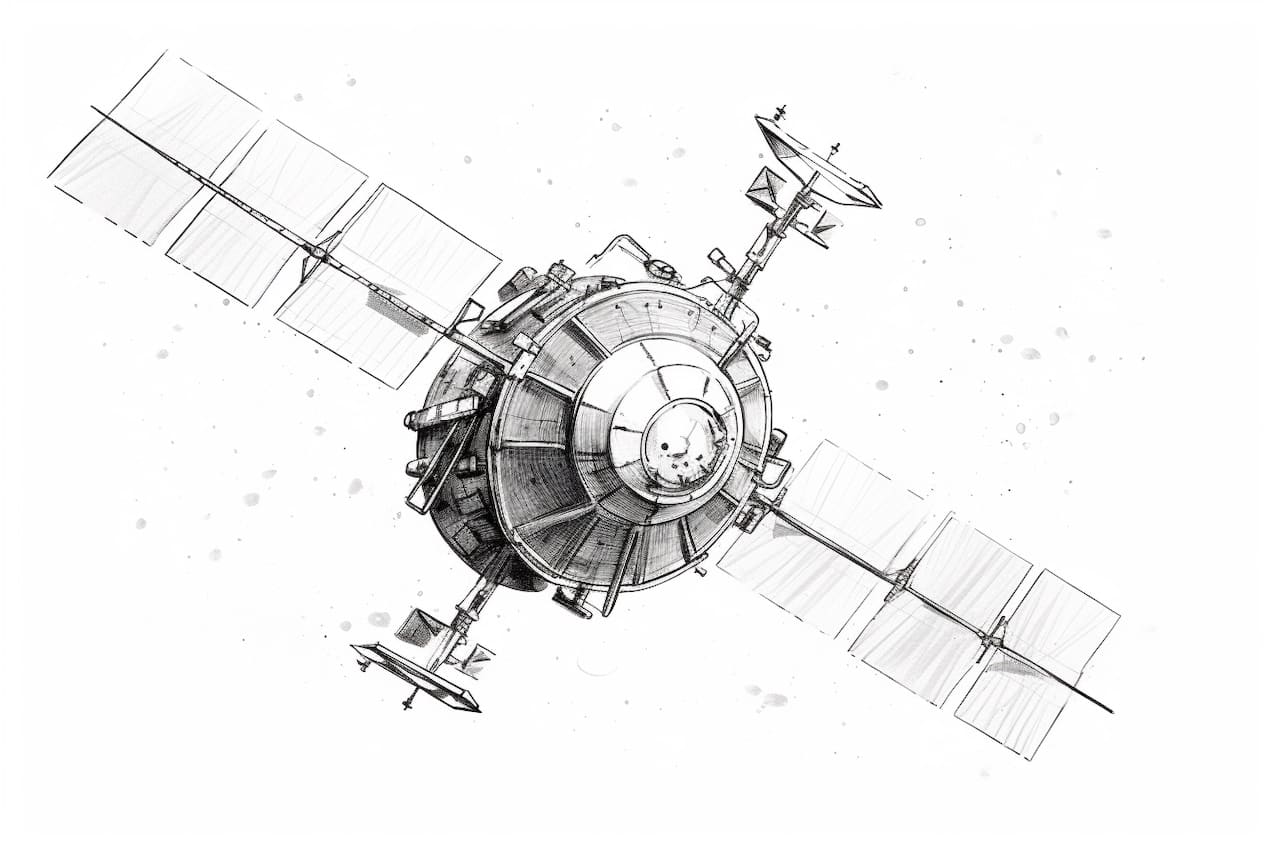Welcome to this step-by-step tutorial on how to draw a satellite. Satellites are fascinating objects that orbit around the Earth, providing a wide range of essential services such as communication, weather monitoring, and navigation. In this tutorial, we will guide you through the process of creating your own satellite drawing, capturing its sleek and futuristic design. So, grab your drawing materials and let’s get started!
Materials Required
To begin your satellite drawing, you will need the following materials:
- Drawing paper
- Pencil
- Eraser
- Fine-tip pen or marker
- Ruler
- Compass
- Colored pencils or markers (optional)
Now that you have gathered all the necessary materials, let’s dive into the step-by-step process of drawing a satellite.
Step 1: Sketch the Basic Shape
Start by sketching a large oval shape in the center of your paper. This will serve as the main body of the satellite. Use light, gentle strokes to create the outline.
Step 2: Add the Antenna
On top of the satellite body, draw a small rectangle shape. This will act as the base for the antenna. From the top of the rectangle, extend two diagonal lines upwards and slightly outwards. Connect these lines at the top with a horizontal line, forming a triangle shape. Finally, add a small oval or circle at the tip of the triangle to complete the antenna.
Step 3: Draw the Solar Panels
On each side of the satellite body, draw a long, narrow rectangle extending towards the back. These rectangles represent the solar panels of the satellite, which provide power. Add some diagonal lines within the rectangles to give them a segmented appearance.
Step 4: Create the Communication Dish
Below the satellite body, draw a curved line connecting the two sides. This forms the communication dish. Extend two diagonal lines downwards from the dish to create a triangular shape. Add a small horizontal line near the bottom of the triangle to complete the dish.
Step 5: Detail the Satellite Body
To give the satellite body some depth, draw a vertical line down the center. Then, add some curved lines along the sides, following the contour of the oval shape. This will create the impression of a three-dimensional object. You can also add small circles or dots randomly on the body to represent various sensors or details.
Step 6: Outline the Drawing
Using a fine-tip pen or marker, carefully trace over the pencil lines to create a clean and defined outline of the satellite. Pay close attention to the details and take your time to ensure accuracy. Once you have outlined the entire drawing, give the ink some time to dry. Then, erase any remaining pencil marks.
Step 7: Add Color (Optional)
Now that the main outline is complete, you can choose to add color to your satellite drawing. Select your preferred medium, such as colored pencils or markers, and begin adding color to the different parts of the satellite. Be creative with your color choices, considering the materials and functions of the satellite. For example, you might want to use metallic or futuristic colors to depict the body, and vibrant colors for the solar panels.
Conclusion
Congratulations on completing your satellite drawing! By following these step-by-step instructions, you have created your own representation of a satellite, showcasing its key features and futuristic design. Remember, drawing is a skill that improves with practice, so keep experimenting and exploring new subjects. We hope you enjoyed this tutorial and found it helpful in enhancing your artistic abilities.
Fun Facts About Satellites
- The oldest satellite still in orbit is the Vanguard 1, launched by the United States in 1958.
- The International Space Station (ISS) is the largest artificial satellite in orbit, spanning the length of a football field.
- Satellites can orbit the Earth in different ways, including polar orbits that pass over the North and South poles, and geostationary orbits that remain fixed over a specific point on the equator.
- GPS satellites provide accurate positioning and navigation services worldwide, enabling technologies like Google Maps and location-based services on smartphones.
- The first satellite to be launched by a private company was the Telstar 1 in 1962, which provided the first live transatlantic television feed.
- Satellites can be used for a wide range of purposes, including weather forecasting, Earth observation, communication, scientific research, and national security.
- The Hubble Space Telescope is a famous satellite that has provided stunning images of distant galaxies and nebulae, revolutionizing our understanding of the universe.
- Many satellites are equipped with solar panels to generate power from the Sun, allowing them to operate in orbit for years.
- Some satellites have been used for space exploration missions, such as the Mars Reconnaissance Orbiter and the Cassini spacecraft that studied Saturn and its moons.
- The concept of satellite communication was first proposed by science fiction writer Arthur C. Clarke in a 1945 article, envisioning a global network of geostationary satellites for broadcasting and communication purposes.
Suggestions for Scenes and Settings for Satellite Drawings
- A detailed close-up of a satellite dish on a rooftop, capturing the intricate metal structure and surrounding cityscape.
- A futuristic city skyline with multiple satellites orbiting above, showcasing a blend of technology and urban landscape.
- A satellite launch pad with a rocket ready for liftoff, emphasizing the anticipation and energy of the moment.
- An artist’s interpretation of a satellite’s journey through space, featuring vibrant colors and abstract shapes to convey movement.
- A serene nighttime scene of a satellite passing through a star-filled sky, highlighting the beauty and vastness of outer space.
- A satellite communication station in a remote, mountainous location, illustrating the contrast between nature and technology.
- A satellite repair mission in outer space, showing astronauts working together to maintain and upgrade the equipment.
- A satellite observing Earth from a distance, capturing the planet’s natural beauty and environmental diversity.
- An imaginative depiction of a satellite as a character or creature, blending elements of science fiction and fantasy.
- A satellite mapping out a digital grid over a virtual landscape, symbolizing the role of technology in shaping our understanding of the world.






